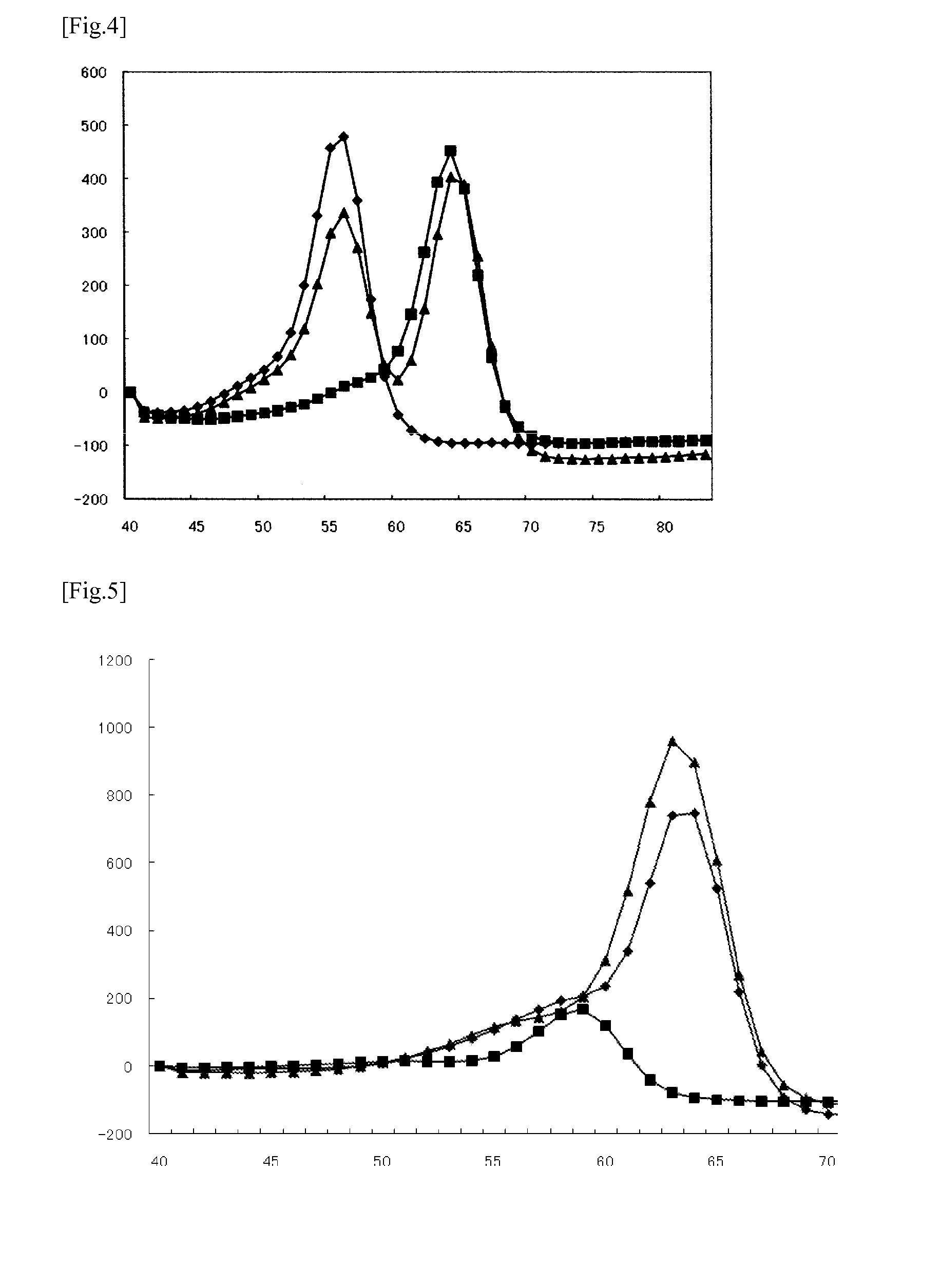Method for detecting mutations at il28b and itpa
- Summary
- Abstract
- Description
- Claims
- Application Information
AI Technical Summary
Benefits of technology
Problems solved by technology
Method used
Image
Examples
example 1
Use of a Single Probe for Detection of Template Oligonucleotide for IL28B
[0117]Based on the nucleotide sequence (SEQ ID NO:1) comprising the polymorphic site rs8099917 in the IL28B gene, the probe shown in Table 1 having C at its 3′-end was designed. In Table 1, the position of the probe is represented by nucleotide positions in the nucleotide sequence shown in SEQ ID NO:1. Labeling with BODIPY FL was carried out according to a conventional method.
[0118]The sequences of the template oligonucleotides used as the subject sequences to be detected (mutant type (SEQ ID NO:10) and wild-type (SEQ ID NO:11)) are shown in Table 1. In Table 1, the position of each oligonucleotide is represented by nucleotide positions in the nucleotide sequence shown in SEQ ID NO:1. A mixture of the template oligonucleotides of SEQ ID NOs:10 and 11 at a ratio of 1:1 was used as a sample for studying the heterozygous sample.
TABLE 1SEQGCIDcontentTmTmNameSequence (5′→3′)PositionNO:mer(%)(mt)(WT)ΔTmIL28B(917) pro...
example 2
Use of a Single Probe for Detection of Template Oligonucleotide for ITPA
[0130]Based on the nucleotide sequence (SEQ ID NO:2) comprising the polymorphic site rs1127354 in the ITPA gene, the probe shown in Table 5 having C at its 3′-end was designed. In Table 5, the position of the probe is represented by nucleotide positions in the nucleotide sequence shown in SEQ ID NO:2. Labeling with TAMRA was carried out according to a conventional method.
[0131]The sequences of the template oligonucleotides used as the subject sequences to be detected (mutant type (SEQ ID NO:15) and wild-type (SEQ ID NO:16)) are shown in Table 5. In Table 5, the position of each oligonucleotide is represented by nucleotide positions in the nucleotide sequence shown in SEQ ID NO:2. A mixture of the template oligonucleotides of SEQ ID NOs:15 and 16 at a ratio of 1:1 was used as a sample for studying the heterozygous sample.
TABLE 5SEQGCIDcontentTmTmNameSequence (5′→3′)PositionNO:mer(%)(mt)(WT)ΔTmITPA(354)tctaggagata...
example 3
Use of a Plurality of Probes for Detection from Purified Human Genomic DNA or Whole Blood
[0143]Polymorphic regions were amplified as described below from purified human genomic DNA or whole blood by PCR using the primers described below, and Tm analysis was carried out using the probes shown in SEQ ID NOs:3 and 4.
[0144]First, the primers shown in Table 9 were designed based on the nucleotide sequence having the polymorphic site rs8099917 in the IL28B gene (SEQ ID NO:1), such that the polymorphic site may be amplified with the primers. In Table 9, the positions of the primers are represented by nucleotide positions in the nucleotide sequence shown in SEQ ID NO:1.
[0145]Further, the primers shown in Table 10 were designed based on the nucleotide sequence having the polymorphic site rs1127354 in the ITPA gene (SEQ ID NO:2), such that the polymorphic site may be amplified with the primers. In Table 10, the positions of the primers are represented by nucleotide positions in the nucleotide...
PUM
| Property | Measurement | Unit |
|---|---|---|
| Fraction | aaaaa | aaaaa |
| Time | aaaaa | aaaaa |
| Electrical resistance | aaaaa | aaaaa |
Abstract
Description
Claims
Application Information
 Login to View More
Login to View More - R&D
- Intellectual Property
- Life Sciences
- Materials
- Tech Scout
- Unparalleled Data Quality
- Higher Quality Content
- 60% Fewer Hallucinations
Browse by: Latest US Patents, China's latest patents, Technical Efficacy Thesaurus, Application Domain, Technology Topic, Popular Technical Reports.
© 2025 PatSnap. All rights reserved.Legal|Privacy policy|Modern Slavery Act Transparency Statement|Sitemap|About US| Contact US: help@patsnap.com



